UNIVERSITY OF SOUTH FLORIDA
Admit-a-bull // official admissions blog, why campus visits matter and what questions to ask.
By Emily Young | Last Updated: Aug 21, 2024

You constantly hear from everyone (your guidance counselor, admissions advisors, and, hey! even the USF admissions blog) that college campus visits are important. But when you’ve got so many options to choose from — tours, open houses, Admitted Students Day, orientation — it’s easy to feel overwhelmed. How can you tell which event is best for you, and how can you make the most of your visit? You’re in luck: We’ve got the answers you’re looking for.
Let’s talk about why campus visits matter and how to make the most of them — including the questions you should ask.

Campus Visits Are Inspirational
High school is a marathon — and sometimes it feels pretty grueling, especially when you can’t yet see the finish line. Glimpsing your post-race reward (life at college) can be inspirational. After all, it’s easier to stay motivated when you can actually picture yourself at college. To develop that mental picture, we recommend dropping by your local campus and getting a taste of what’s waiting for you, even as early as freshman year .
“We absolutely welcome first-year high school students if they’re interested in coming on campus,” says Freddie O’Brion, the Campus Tour Manager at USF Tampa.
Bring your friends along for an official tour, sign up for an open house, or explore at your own pace. Whatever you choose, the point is to have fun! Act like you’re in college:
- Grab a slice of pizza at the food court.
- Visit that state-of-the-art marine science building and envision yourself learning how to save the manatees.
- Check out the on-campus art museum and picture your work on display.
- Walk past the recreation center to get a peek at its resort-style swimming pool and busy basketball courts.
- Observe the freedom of college life — students coming to and from residence halls, meeting up with new friends, and hustling to events like comedy nights, movies on the lawn, and Homecoming.
All that kinda makes you want to study for the SAT, doesn’t it?
Make the Most of Your Visit
While you’re on campus, it doesn’t hurt to ask for some pro tips on college prep. “At USF, our admissions office is open for walk-in appointments every weekday,” O’Brion says. “Our admissions advisors are some of the most knowledgeable experts … about what kinds of things you need in order to get into a university.”
Don’t stress about this meeting — it’s not an admissions interview, but simply a chance for you to get the inside scoop. An advisor can tell you how to approach standardized tests, what course credits actually matter, and strategies to make your high school years count. You won’t just leave inspired: you’ll have a game plan, too.
What Questions Should You Ask on a Freshman College Visit?
Ask yourself these questions:
- What excites me about college?
- What do I picture myself studying here? (There’s no rush to figure out your college major — that’s why schools offer exploratory programs ! But throughout high school, check in with yourself about what academic fields, classes, and careers interest you.)
- What extracurriculars and campus clubs look cool to me? Can I get involved in — or even start — something similar at my high school?
Ask the admissions advisor these questions:
- What should I be doing in my high school years to prepare for college?
- What’s the best way to approach standardized tests?
- What is a “high school resume” and how should I start one?

Campus Visits Help You Narrow Your College Application List
Sophomore year is the perfect time to check out nearby colleges and universities. Next, between the spring of your junior year and fall of your senior year , you’ll want to intentionally visit your target schools, including campuses out-of-state. So, what are your options for college visits?
- A virtual tour . Visiting a ton of different schools can get pricey — especially if they’re spread across the country. “For folks who maybe aren’t sure if they can or want to spend the money to fly in from out of state, I would recommend exploring our pretty robust virtual offerings,” says O’Brion. USF’s virtual tours include 360° panoramic photos that practically transport you to one of our three sunny campuses. Plus, the virtual tours include audio from guides who are current students, so you’ll still discover the campus’ best-kept secrets.
- A self-guided tour. Are you an introvert who’d rather explore the campus on your own? Download a self-guided tour app — an underutilized resource, according to O’Brion: “It gives you all of the information that you would get on a guided tour, but you can do it at your pace.”
- An official campus tour. In the traditional campus tour, you’ll join a group led by a college student guide. The perks? You can ask the tour guide to share their own experiences, giving you valuable insight as you navigate the campus.
- An open house . If you’re serious about the school, an open house might be your best bet, because it includes more activities than the standard tour. At a USF open house, you can explore campus, chat with faculty and current students, hear from financial aid officers, and learn about academics and campus life. “If you’re in your last semester of junior year or you’re a senior, you’re probably going to want to go to an open house so you can get a more in-depth overview of USF,” says Paige Maciaszek, Admissions Special Events Coordinator at the Sarasota-Manatee campus.
- Other admissions events . Contact your local campus to find out what special events they offer. For example, USF Sarasota-Manatee hosts a “college prep night” where high school juniors and seniors can learn general tips about the college search and application process.
Keep in mind that there is no right or wrong way to visit campus. At this stage of the process, the whole point is helping you decide where to apply.
“Frankly, we’re not going to make any admissions decisions based on what events you did or didn’t attend,” O’Brion says. “If you’re looking at all of your options, I really recommend picking what feels best, exciting, and interesting to you, and what works well with your schedule.”
Before visiting in person, research the school so you’ll know what questions to ask and what majors or clubs interest you. Then set up meetings with admissions and financial aid officers, and, if possible, professors in your field(s) of interest. Snag any chance you get to sit in on a class and don’t forget to soak up the campus and surrounding area. Could you see yourself thriving here for four years?
Here’s another tip for out-of-state students: If you’re worried about a big change in climate, you might want to visit during the “worst weather” season. “For Florida, that’s obviously going to be summer and then early fall when it’s usually the hottest,” says Maciaszek. “But to be honest, our campus is beautiful year-round.” (Just make sure you bring sunscreen and plenty of water.)
What Questions Should You Ask on a College Visit?
The school’s website should answer most of your basic questions, such as:
- What is the freshman retention rate?
- How many majors are offered?
- What is the student-to-faculty ratio?
- What extracurricular activities/clubs can students get involved in?
- What on-campus housing is available?
- What are meal plans like?
- What is the diversity of the student population?
- How many classes are taught by professors rather than teaching assistants?
- What special programs and academic opportunities (such as Honors Colleges and undergraduate research) are available?
- What internships and career support are available?
- What resources and support systems are offered (health clinics, counseling centers, gyms, libraries, tutoring centers, etc.)?
- What financial aid and scholarships are available?
- What are the school’s rankings and recognitions?
- What are the school’s four-year and six-year graduation rates?
You can also find out a lot of information about a school’s reputation on third-party websites, like the Princeton Review’s list of the 209 “Best Value Colleges” or the College Scorecard , which is like a Consumer Reports for higher education.
If you can answer these general questions before your visit, then you can ask your student tour guide more specific questions.
- What’s the food like?
- Why did you choose this school?
- What do students do for fun on the weekends?
- What’s your favorite and least favorite thing about the school?
- What are the professors like?
- Where would you recommend students look for work on campus?
- What advice would you give to students considering this school?
“Those student tour guides are the experts,” says Maciaszek. “They might be able to tell you, ‘Here’s how to set yourself up for academic success,’ because they've lived that experience.”
Admitted Students Day Helps You Celebrate Your Acceptance — and Make a Decision
Once you’ve been accepted to a school, Admitted Students Day can help you make your final decision. In fact, if your budget only allows you to visit an out-of-state school one time, you may want to save your trip for this event.
Here’s what you should know:
- Admitted Students Day events are an important way to get in-depth information about whether the school is right for you. Along with a tour of campus, you should get the chance to meet current and prospective students, connect with faculty, learn about academics and extracurriculars, and get practical information on housing, dining, support services, and financial aid.
- Typically, the event lasts a day or half-day and is held in the spring. At USF, Admitted Students Day events take place from January through April.
- You’re welcome to attend whether you’ve already accepted the school’s offer of admission or you’re still deciding.
- Your family can attend with you.
- If you can’t visit in person, many schools offer virtual Admitted Student Days, including USF.
If you’re choosing between schools, take notes at each Admitted Students Day, then make a comparison chart. Weigh important criteria like financial aid, location, majors, extracurriculars, study abroad opportunities, and general vibes.
Remember to have fun at this event! It’s time to celebrate all you’ve accomplished. This school is trying to wow you! That ought to feel good. (Plus, you might even meet your future roommate at one of the activities).
What Questions Should You Ask at Admitted Students Day?
Read through your admissions packet thoroughly so you know the right questions to ask. At this point, you’re seriously considering this school, so you’ll want to get specific.
- What financial aid and scholarship opportunities can the school offer me?
- How can this college help me achieve my academic goals?
- What are graduates in my field doing now?
- What are the regional internship and job opportunities for my field?
- What student success resources does the school offer? (Think about resources that may be especially important to you, such as free mental health counseling or disability accommodations in residence halls.)
- What would my transition to the school look like?

Orientation Is Essential for College Success
Once you accept a school’s offer of admission, you’ll need to attend an orientation session. Most schools require this event: at USF, for example, you won’t be able to sign up for classes until you attend Orientation.
Here’s what you should know about college orientation:
- At orientation, you’ll meet faculty and staff, connect with other incoming students, learn about academic requirements, get familiar with school resources, and conduct business, like picking up your university ID card. You can also meet with an academic advisor and register for classes.
- Orientation sessions can last anywhere from a day to a week, depending on your school. At USF, the sessions are limited to one day.
- Some schools may offer virtual orientations if you can’t attend in person.
- Register online to choose the date that you want to attend. Unlike other events covered in this article, orientation may cost a fee, so contact the orientation team at your school if this causes you financial difficulty.
- Your parent or guardian can attend family sessions.
Make The Most of Your Visit
Be sure to submit any required documents (like immunization records or documentation of dual enrollment credits) before orientation. Your school will tell you what they need.
If possible, bring your unofficial transcript to orientation so your advisor can see what classes you’ve taken in high school and help you choose the right courses for college. This is especially helpful if you’re starting in the summer and your final transcript isn’t available yet.
What Questions Should You Ask at College Orientation?
At this point, you’re ideally committed to attending this school. Now your questions are no longer about whether it would be a good fit for you, but about how you can successfully make the transition. For example:
- What’s covered in the meal plan?
- What housing options are available to me?
- How do I access health and wellness resources on campus?
- Who can I talk to if I feel overwhelmed during the semester?
- What campus security features/emergency alerts should I know about?
- How do I drop or add a class?
- How do I declare a major?
- How do I access career counseling and how can career counselors help me during my freshman year?
- Can you tell me more about my financial aid and tuition payment options?
- How can I get involved in campus life?
- What first-year experiences are available to freshman students?
Reach Out to Admissions Officers
We know visiting colleges can be a big deal. That’s why we’ve created so many blog posts on the topic. Consult these resources for more in-depth tips:
- How to Prepare for a Campus Tour
- How Campus Visits and Tours Can Affect Your College Decision
- What’s the Best Type of Campus Tour?
- Questions to Ask on a Campus Tour
- College Campus Visits in Summer
- College Campus Visits in Winter
- Tips For Traveling to Out-Of-State Colleges of Interest
- Top Tips for Planning College Road Trips
- Take a Campus Tour from Home
Considering USF? We’d love to welcome you on campus! Reach out to the Office of Admissions or schedule your tour online today!

About Emily Young
Emily Young is a freelance writer and editor based on the gulf coast of Florida. A proud USF alumna, she cares about connecting readers to resources and helping students find success.
Previous Post

College Resources for Homeless, Unhoused and Housing-Insecure Students
- PRO Courses Guides New Tech Help Pro Expert Videos About wikiHow Pro Upgrade Sign In
- EDIT Edit this Article
- EXPLORE Tech Help Pro About Us Random Article Quizzes Request a New Article Community Dashboard This Or That Game Happiness Hub Popular Categories Arts and Entertainment Artwork Books Movies Computers and Electronics Computers Phone Skills Technology Hacks Health Men's Health Mental Health Women's Health Relationships Dating Love Relationship Issues Hobbies and Crafts Crafts Drawing Games Education & Communication Communication Skills Personal Development Studying Personal Care and Style Fashion Hair Care Personal Hygiene Youth Personal Care School Stuff Dating All Categories Arts and Entertainment Finance and Business Home and Garden Relationship Quizzes Cars & Other Vehicles Food and Entertaining Personal Care and Style Sports and Fitness Computers and Electronics Health Pets and Animals Travel Education & Communication Hobbies and Crafts Philosophy and Religion Work World Family Life Holidays and Traditions Relationships Youth
- Browse Articles
- Learn Something New
- Quizzes Hot
- Happiness Hub
- This Or That Game
- Train Your Brain
- Explore More
- Support wikiHow
- About wikiHow
- Log in / Sign up
- Education and Communications
- Official Writing
- Report Writing
How to Write a Visit Report
Last Updated: March 30, 2024 References
This article was co-authored by Madison Boehm . Madison Boehm is a Business Advisor and the Co-Founder of Jaxson Maximus, a men’s salon and custom clothiers based in southern Florida. She specializes in business development, operations, and finance. Additionally, she has experience in the salon, clothing, and retail sectors. Madison holds a BBA in Entrepreneurship and Marketing from The University of Houston. This article has been viewed 677,059 times.
Whether you’re a student or a professional, a visit report helps you document the procedures and processes at an industrial or corporate location. These reports are fairly straightforward. Describe the site first and explain what you did while you were there. If required, reflect on what you learned during your visit. No additional research or information is needed.
Writing a Visit Report
Explain the site's purpose, operations, and what happened during the visit. Identify the site's strengths and weaknesses, along with your recommendations for improvement. Include relevant photos or diagrams to supplement your report.
Describing the Site

- Reports are usually only 2-3 pages long, but in some cases, these reports may be much longer.
- In some cases, you may be asked to give recommendations or opinions about the site. In other cases, you will be asked only to describe the site.
- Ask your boss or instructor for models of other visit reports. If you can't get a model, look up samples online.

- If you visited a factory, explain what it is producing and what equipment it uses.
- If you visited a construction site, describe what is being constructed and how far along the construction is. You should also describe the terrain of the site and the layout.
- If you’re visiting a business, describe what the business does. State which department or part of the business you visited.
- If you’re visiting a school, identify which grades they teach. Note how many students attend the school. Name the teachers whose classes you observed.

- Who did you talk to? What did they tell you?
- What did you see at the site?
- What events took place? Did you attend a seminar, Q&A session, or interview?
- Did you see any demonstrations of equipment or techniques?

- For example, at a car factory, describe whether the cars are made by robots or humans. Describe each step of the assembly line.
- If you're visiting a business, talk about different departments within the business. Describe their corporate structure and identify what programs they use to conduct their business.
Reflecting on Your Visit

- Is there something you didn’t realize before that you learned while at the site?
- Who at the site provided helpful information?
- What was your favorite part of the visit and why?

- For example, you might state that the factory uses the latest technology but point out that employees need more training to work with the new equipment.
- If there was anything important left out of the visit, state what it was. For example, maybe you were hoping to see the main factory floor or to talk to the manager.

- Tailor your recommendations to the organization or institution that owns the site. What is practical and reasonable for them to do to improve their site?
- Be specific. Don’t just say they need to improve infrastructure. State what type of equipment they need or give advice on how to improve employee morale.
Formatting Your Report

- If you are following a certain style guideline, like APA or Chicago style, make sure to format the title page according to the rules of the handbook.

- Don’t just say “the visit was interesting” or “I was bored.” Be specific when describing what you learned or saw.

Sample Visit Report

Community Q&A
You Might Also Like

- ↑ http://services.unimelb.edu.au/__data/assets/pdf_file/0010/471286/Site_Reports_for_Engineers_Update_051112.pdf
- ↑ https://www.examples.com/business/visit-report.html
- ↑ https://www.thepensters.com/blog/industrial-visit-report-writing/
- ↑ https://eclass.aueb.gr/modules/document/file.php/ME342/Report%20Drafting.pdf
About This Article

To write a visit report, start by including a general introduction that tells your audience where and when you visited, who your contact was, and how you got there. Once you have the introduction written out, take 1 to 2 paragraphs to describe the purpose of the site you visited, including details like the size and layout. If you visited a business, talk about what the business does and describe any specific departments you went to. Then, summarize what happened during your visit in chronological order. Make sure to include people you met and what they told you. Toward the end of your report, reflect on your visit by identifying any strengths and weaknesses in how the site operates and provide any recommendations for improvement. For more help, including how to format your report, read on! Did this summary help you? Yes No
- Send fan mail to authors
Reader Success Stories
Betty Tarutia
Jul 9, 2020
Did this article help you?

Jayani Rathnayake
Aug 6, 2019
Jun 13, 2019
Atremedaki Phawa
Aug 19, 2019

Featured Articles

Trending Articles

Watch Articles

- Terms of Use
- Privacy Policy
- Do Not Sell or Share My Info
- Not Selling Info
Don’t miss out! Sign up for
wikiHow’s newsletter
This site uses various technologies, as described in our Privacy Policy, for personalization, measuring website use/performance, and targeted advertising, which may include storing and sharing information about your site visit with third parties. By continuing to use this website you consent to our Privacy Policy and Terms of Use .
We are experiencing sporadically slow performance in our online tools, which you may notice when working in your dashboard. Our team is fully engaged and actively working to improve your online experience. If you are experiencing a connectivity issue, we recommend you try again in 10-15 minutes. We will update this space when the issue is resolved.
Enter your email to unlock an extra $25 off an SAT or ACT program!
By submitting my email address. i certify that i am 13 years of age or older, agree to recieve marketing email messages from the princeton review, and agree to terms of use., 60 questions to ask on your college tour.
Want to know what life’s really like at your dream school? Chat up the real experts on campus—the students.
When you tour colleges, make sure you talk with as many current students as you can. Ask them what they love and what bothers them most about their schools. This list of potential questions will help you spark some conversations with students on all your college visits , so you can find the school that fits you best.

Why did you choose this school?
Are you happy here?
What are your school's strengths?
What’s your #1 complaint about your school?
What else could stand to be improved?
How accessible are administrators, registrars, financial aid officers, etc.?
What majors are popular?
What departments or programs have the best reputations?
What’s your favorite class?
Are your professors good teachers?
Do your professors hold office hours, and will they meet with you outside of class?
Are most of your classes taught by professors or teaching assistants?
Were you able to take most of your first-choice classes?
Are your classes lecture-based or discussion-based?
How much reading and writing is required in your courses?
How often are collaborative work or group presentations required?
How satisfied are you with academic advising?
Do students use any on-campus tutoring programs or writing centers?
How big are your classes?
Does your major require an independent study or capstone project ?
Are professors available for research with students?
Is it popular to study abroad ?
Free SAT Practice Tests & Events
Evaluate and improve your SAT score.
Campus Life
What's it like to be a first-year student here?
What's a typical day like?
How much time do students spend studying per week?
What do you do when you're not in class?
What do you do on the weekends?
What is the social scene like?
What kinds of things are there to do in your school's hometown?
How’s the food ?
Do most students live on-campus?
How are the dorms ?
Which clubs and student organizations are popular?
Do lots of students belong to fraternities or sororities?
What's your favorite place on campus?
Where do you like to study?
What are the facilities like (science labs, libraries , theatres, gyms, etc.)?
Are there enough computer labs?
How is the WiFi on campus?
Is it easy to get around campus?
Are sports popular?
Is there a lot of school spirit?
Read More: Search for Colleges
Student Body
How would you describe your fellow students?
Are the students here friendly?
What makes the student body unique?
Is there diversity on campus?
Are there many students from other countries?
Do students of different races and classes interact easily?
Are students cliquish?
Career Services
Are internships available? How do you find them?
Is Career Services helpful?
Do you have a mentor?
Does your school have a co-op program ?
Are there opportunities to build leadership skills on campus?
What options exist for service learning in the community?
Do employers recruit students on campus?
How easy is it to find summer jobs and other kinds of work through your school?
Who are some of the notable graduates from your college?
How visible is your school's alumni association on campus?
What kinds of hands-on or practical experiences have you had in and outside of the classroom?
You can find academic information, campus life stats, and more—including quotes from real students—in our college profiles . Search for a school on your list, or check out our Best Colleges rankings.
Looking for strategic college advice?
Get one-on-one help from former Ivy League and top tier admission officers. Our College Admission Counselors will help you find, apply, and get accepted to your dream school.

Explore Colleges For You
Connect with our featured colleges to find schools that both match your interests and are looking for students like you.

Career Quiz
Take our short quiz to learn which is the right career for you.

Get Started on Athletic Scholarships & Recruiting!
Join athletes who were discovered, recruited & often received scholarships after connecting with NCSA's 42,000 strong network of coaches.

Best 389 Colleges
165,000 students rate everything from their professors to their campus social scene.
SAT Prep Courses
1400+ course, act prep courses, free sat practice test & events, 1-800-2review, free digital sat prep try our self-paced plus program - for free, get a 14 day trial.

Free MCAT Practice Test
I already know my score.

MCAT Self-Paced 14-Day Free Trial

Enrollment Advisor
1-800-2REVIEW (800-273-8439) ext. 1
1-877-LEARN-30
Mon-Fri 9AM-10PM ET
Sat-Sun 9AM-8PM ET
Student Support
1-800-2REVIEW (800-273-8439) ext. 2
Mon-Fri 9AM-9PM ET
Sat-Sun 8:30AM-5PM ET
Partnerships
- Teach or Tutor for Us
College Readiness
International
Advertising
Affiliate/Other
- Enrollment Terms & Conditions
- Accessibility
- Cigna Medical Transparency in Coverage
Register Book
Local Offices: Mon-Fri 9AM-6PM
- SAT Subject Tests
Academic Subjects
- Social Studies
Find the Right College
- College Rankings
- College Advice
- Applying to College
- Financial Aid
School & District Partnerships
- Professional Development
- Advice Articles
- Private Tutoring
- Mobile Apps
- International Offices
- Work for Us
- Affiliate Program
- Partner with Us
- Advertise with Us
- International Partnerships
- Our Guarantees
- Accessibility – Canada
Privacy Policy | CA Privacy Notice | Do Not Sell or Share My Personal Information | Your Opt-Out Rights | Terms of Use | Site Map
©2024 TPR Education IP Holdings, LLC. All Rights Reserved. The Princeton Review is not affiliated with Princeton University
TPR Education, LLC (doing business as “The Princeton Review”) is controlled by Primavera Holdings Limited, a firm owned by Chinese nationals with a principal place of business in Hong Kong, China.
Important Addresses

Harvard College
University Hall Cambridge, MA 02138
Harvard College Admissions Office and Griffin Financial Aid Office
86 Brattle Street Cambridge, MA 02138
Social Links
If you are located in the European Union, Iceland, Liechtenstein or Norway (the “European Economic Area”), please click here for additional information about ways that certain Harvard University Schools, Centers, units and controlled entities, including this one, may collect, use, and share information about you.
- Application Tips
- Navigating Campus
- Preparing for College
- How to Complete the FAFSA
- What to Expect After You Apply
- View All Guides
- Parents & Families
- School Counselors
- Información en Español
- Undergraduate Viewbook
- View All Resources
Search and Useful Links
Search the site, search suggestions, virtual tour, explore harvard from home.
Use our Virtual Tour to discover spaces that aren't even available on an in-person campus tour, such as classrooms, laboratories, residence halls, and more. Even better, it's available 24 hours a day, seven days a week, and never reaches capacity.
Harvard College Virtual Tour
Register for an online information session.
After you tour our campus virtually, take the next step and join us for an online information session! In these hour-long sessions, an admission officer and a student will share information about Harvard College and answer the questions you submit through the chat. View our schedule of upcoming sessions and register today!
Related Topics
Student life.
From the moment first-year students walk into Harvard Yard until they graduate, they are surrounded by people dedicated to making Harvard “home.”
Student Stories
Read stories from current students about their intellectual, social, and personal experiences at Harvard.
Harvard College is a close-knit undergraduate program situated within Harvard University.
Toggle Admissions Submenu
- {{children.title}} {{currentYear}} {{children.title}}
- Manage Account
- Best 529 plans of 2024
- Your state's 529 plan
- Compare 529 plans
Questions to Ask Admissions on a College Campus Visit
By Brian O'Connell
July 2, 2019
Taking your high school student on a college tour is a rite of passage for both the student and the parent. But, too often it doesn’t deliver maximum impact on the family’s college experience because many parents aren’t asking the right questions.
Why not? Several factors affect the gathering of information during the campus tour . Sometimes, tour guides – who are almost always students – don’t possess comprehensive knowledge on important issues like financial aid or the intricacies of the college’s admissions policy.
Or even more often, parents and students are told they’re free to ask any questions they want, from a broad selection of college officials, but neglect to do so. The parents may feel like they don’t have the time to break off for an individual question and answer session. Sometimes, the parents assume they’ll get the information in the tour package or later over the phone with a college advisor.
Additionally, sometimes parents don’t ask the right questions because they don’t know the right questions to ask.
Parents also feel they can get their questions answered , either by word of mouth from other parents whose own children have attended the college or via the college’s web site or social media presence.
Those are decent sources of information, as is a call to the college for a question on tuition, campus life or admissions. But not asking the right questions of the right college administrator while on a campus tour seems like an unforced error for parents and students.
Here’s a fix for that.
Seven Admissions Questions to Ask When You’re on a Campus Visit
Don’t let good information gathering opportunities slip through your fingers, especially on all-important college admissions queries . Be sure to ask these admissions questions during your next college visit, and pave the way for a smooth transition from high school life to college life for your son or daughter.
Can I get a hold of a college admissions officer today while I’m on campus?
Right out of the gate, this should be your first question on a college tour – ask it right away as you and your student arrive for the visit.
Most colleges will make administrators available to some extent during a campus visit, but since college tours are scheduled so frequently over the summer months, there are no guarantees.
Also, as so many college admissions staff may be away on vacation or already booked during the summer months, reality dictates that you ask upfront who’s available from college admissions when you arrive for a college tour – and how, where and when you can find that administrator.
What qualities do you look for in new students?
On this query, a campus tour guide may give you a boilerplate answer straight from the training seminar he or she took to become a tour guide. So unfortunately, it’s a question you might have to ask several times of different people to get a straight answer.
Yet it’s worth the effort.
Stop by the student life and/or college admissions office and ask the question – you’ll want to know what makes students at a given school unique and attractive as admissions candidates.
It might save you from sending your daughter or son to the wrong college and help you steer your child to the right college.
How many new students wind up transferring to another college by their sophomore year?
Ask the college admissions office how many freshman students don’t return for their second semester of their freshman year or for their sophomore year. Also, ask a junior or senior student what kept them coming back to campus during their later college years.
Students leave a college for plenty of reasons. They can’t afford it, they don’t believe college is right for them, or their college is failing them in key areas like academic support. A robust retention rate is a sign that the college knows what’s it’s doing and will keep your son or daughter engaged for four years.
That’s not always easy. According to U.S. News & World Report , one-third of freshman students don’t return to the same college the next academic year.
You’ll want to know your college’s freshman “leave” rate and an admission’s staffer should have one for you while you’re on campus.
The college might report their retention rate, which is the percentage of first-time, full-time freshmen who return for their sophomore year. Subtract the retention rate from 100% to determine what percentage of freshmen leave by the sophomore year. The top 100 national universities have a retention rate of 89% or more and the top 100 liberal arts colleges have a retention rate of 84% or more.
Are there good work-study opportunities on campus?
Any incoming college student will appreciate a few extra bucks every week and a part-time work-study job can fit the bill.
Consequently, asking early about work-study job opportunities can put you at the front of the line for quality part-time work at a decent per-hour salary (at least for an 18-year old college student). A tour guide or student employment office staffer should point you in the right direction.
Make sure you’ve filled out the Free Application for Federal Student Aid (FAFSA) first and ask if the college can place your student in a work-study job in his or her field of study.
Are there ongoing career consulting opportunities on campus?
Yes, graduation is more than four years away (more if your child moves on to graduate school) but it’s never too early to find out the quality of a given college’s career services program.
Parents and students who want that information should focus on several metrics of the college’s job placement performance:
- The track record of a school’s professional job placement office
- The track record of the college’s job placement efforts in the student’s major/vocation
- The availability of career fairs on campus
Also consider the ability to connect with alumni through local and regional professional organizations, which can lead directly to good job opportunities for graduates.
Since the ultimate goal of any campus visit is to choose a college that will train your child for a professional career with a good job right out of school, all of the above should be on your list of career questions on campus tour day.
Does the college have a favorable bias toward early admissions candidates?
Most colleges and universities offer at least two forms of admissions acceptance: early admissions and regular admissions.
Each has its advantages and disadvantages and parents who understand how a particular college prefers to accept students for admissions has some leverage other parents don’t.
For instance, if the word from an admissions college administrator, or even from “in the know” current students, says that their college likes to lock in early admissions candidates and is less enamored of regular admissions candidates, applying early might improve the raw odds of being accepted.
But, be sure you understand the difference between early decision and early action applications. With an early decision application, the student commits to enroll if admitted early. An early decision application is binding, while an early action application is not.
Consequently, asking about the percentage of incoming freshman who were accepted as early admission or regular admission candidates can tilt the admissions odds in your favor.
That alone makes it a question worth asking.
What level of student support should we expect on campus?
Different colleges have different levels of support for students, and you’ll want to know where your son or daughter stand if they need support on a wide range of student academic and life issues.
How will my child work with an academic advisor? Who can steer my student into a good “study abroad” program?” What is my child gets sick or suffers from a stress or anxiety issue at your college? Who can we turn to and what services do you offer students for general academic and life issues at your college or university?
Those questions and more deserve an answer if you’re going to spend potentially tens of thousands of dollars annually to place your child at a specific college.
A candid discussion with an admissions representative can get you the information on student services that you need.
A final bit of advice for anxious parents of college-bound students:
Don’t ask all the questions.
Give your student the space they need to ask questions of importance to them. At the end of the campus tour, get lost, so your child can ask a few questions without you breathing over their shoulder.
Related Articles

Where To Open a 529 Plan: What To Consider When Selecting a Plan

Can You Use a 529 Plan to Pay for Health Insurance?

What’s the Average Cost of College Tuition in 2024?

Survey: New Roth IRA Benefit Likely to Impact 529 Plan Usage and Contributions
SPONSOR CENTER
A good place to start:
See the best 529 plans, personalized for you

Unlock Printing
Already have an account? Log in
- Request Info
- Browse Degrees
- Quizzes and Checklists
- SLU Student Profiles
- Give to SLU
- Search & Directory
What To Ask on Campus Tours
If you have questions about what college is like, campus tour guides have the answers. You'll get a lot out of visiting colleges, but at Saint Louis University, the campus tour guides are current undergraduate students — so they won't just tell you about dorms, they can also tell you where to get a good grilled cheese sandwich, if they feel safe walking around campus at night and if you can paint your dorm room. (Sorry; the answer to that that last one is no, by the way.)
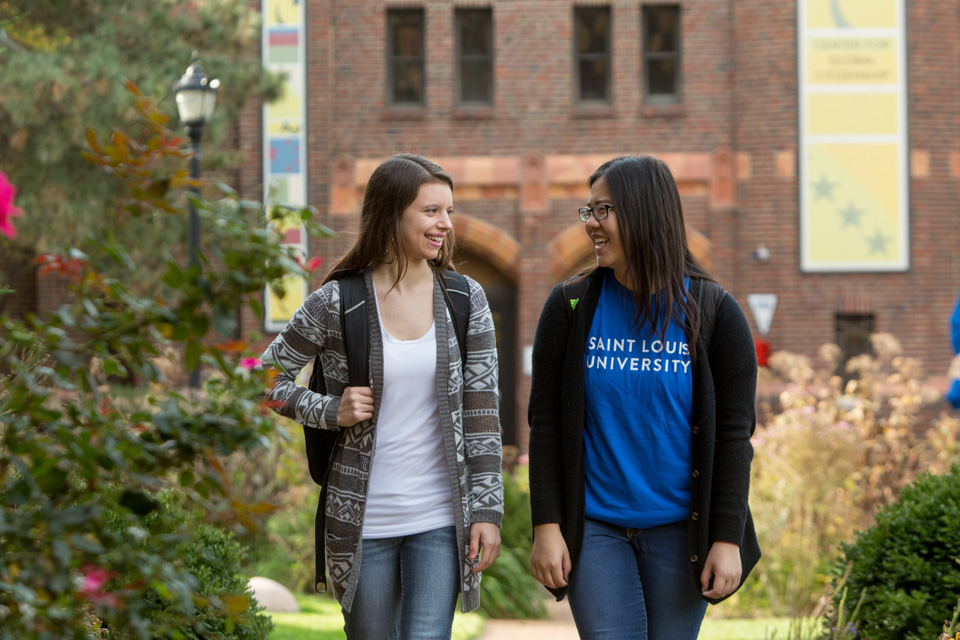
What Happens on a Campus Tour?
"Showing off campus is like showing off my home," says one tour guide, who at SLU are known as “ambassadors.” Here are some of the most popular questions our ambassadors hear, and a few suggestions for things to ask on your tour:
- Why did you choose SLU?
- How often do students go home on the weekends?
- What's it like in the residence halls?
- What's a Billiken?
But SLU's tour leaders will also give you a personal look at campus. "I try to keep my campus tours in the first person," says another ambassador. "I tell my guests, 'I like to go to Busch Student Center ; this is where I sit in class; this is where my friends come to throw a Frisbee around; that kind of stuff.'"
Don't Ask These College Questions
Are there any questions you shouldn't ask on a college tour? Keep the focus on yourself, not your guide. So stay away from asking them about their GPA, their SAT score, their financial aid package and other topics that might be sensitive.
But never hesitate to ask a question about the university's academics, campus life or even the architectural features you notice around campus. (At SLU, highlights include the gorgeous view inside College Church and Samuel Cupples House — some people think it looks like Hogwarts.)
"The best part is when the campus tour ends and a student says to me that she can tell how much I love my school," a SLU ambassador says.
At SLU, there are actually two ways to connect with current students. One is on the campus visit . The other is the Billiken Buddy program, where high school students hang out with undergrads for a night in the residence halls and shadow them to classes.
Schedule a SLU Visit
- More College Search Advice
- College Quizzes and Checklists
- Watch Videos
- Campus Directory
- Current Students
- Faculty & Staff

IT Division
Annual Report 2023‑24

featured stories
Every year, Weber State University strives to provide transformative educational experiences for students of all identities and backgrounds through meaningful personal connections with faculty and staff in and out of the classroom.
USHE Concurrent Enrollment Participation Form
Concurrent Enrollment (CE) refers to enrollment by high school students in one or more Utah System of Higher Education (USHE) institution course(s) under a contractual agreement between an Institution and Local Education Agencies (LEAs). Students continue to be enrolled in their high schools, to be counted in Average Daily Membership and to receive credit toward graduation. Concurrent students also receive college credit for courses. The purpose of CE is to allow eligible high school students to enroll in college courses that would enable them to earn credit concurrently toward high school graduation and a postsecondary certificate or degree.
The IT Division Student Applications team manages all software deployment projects for Admissions, Student Access and Success (SAS), Financial Aid, and Registration.
The USHE CE Participation Form Project was a state-mandated project to adhere to a single Admissions form for all Utah Higher Education institutions. This project was a collaboration with Ellucian, Utah State Board of Education (USBE)/USHE, and Utah State University (USU). The WSU IT Division Student Applications team was responsible for project management and technical expertise to coordinate with USBE and Ellucian. Mark Isakson (WSU Programmer/Analyst Architect) is WSU’s USHE Technical expert and drove the engagement with USBE to get contacts assigned to the project. IT efforts were the reason this project was completed on time.
Students fill out the USHE concurrent enrollment application which can admit them as concurrent at multiple colleges in Utah using the same application. The student pays the application fee for each college they apply for admission to on the USHE application. Students must include their Utah SSID number. The WSU applications are pushed to WSU’s CRM Recruit, which auto-admits the student and pushes the admitted application to Banner.
Concurrent Enrollment Participation Form

"Since we turned on the USHE CE application and high schools started utilizing the form, we've admitted 2,988 new CE students. This project has been a 'herculean' effort by all parties involved. Thank you for all the hard work and patience."
- Scott Teichert , Assistant Vice President for Access One week after the project went LIVE in August 2023
Ken Garff Success in Education Esports Tournament
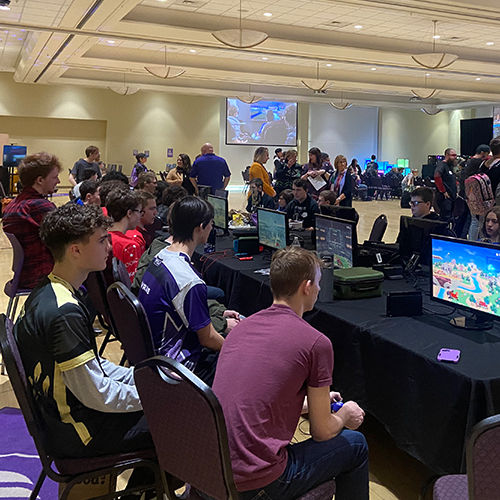
Speakers for our event were Brant Brown – Admissions, Tyler Oelling – Esports Coordinator, Kathy Garff – Ken Garff Automotive Group, and our Keynote speaker Dr. Jessica Oyler – Vice President of Student Access and Success. Also, in attendance to table the event from Hill Air Force Base, representing Air Force Gaming, Space Age Gaming, WSU Dreamers, WSU Labs, WSU Esports and WSU General Admissions. The winning teams for each game were Bountiful for Mario Kart, Farmington for Rocket League (second year in a row), and Bountiful again for Super Smash Bros.

Google Migration Project
The Google Migration Project allowed the IT Division to address technical debt that inhibited the ability to move forward with important security and risk management initiatives. Weber State University (WSU) began the transition to Google Workspace in 2012 and, at the time, students were transitioned first. Because of this, there were two separate Google Workspace accounts. This presented some problems down the road when Google removed unlimited storage for education customers and required student licenses to purchase faculty/staff licenses. Migrating students to the primary domain allows WSU to better protect these accounts against advanced security threats, while also enabling students more features of Google Workspace, such as expanded storage options. This simplifies the management of Google Workspace and improves the collaboration between students and faculty.

" As a new team member in the IT Division, taking on the role of Project Manager for the Google Migration Project was a privilege. It was a significant project that had a direct impact on the entire community, and I am proud of the dedication and hard work the project team put in to ensure its success. "
- Mark Journigan , Systems Administration Manager Project Manager
Web and Document Accessibility Resource Websites

Jeremy Harvey, IT Division-Academic Web Services (AWS) Senior Manager, completed his Master of Professional Communication in Fall 2023 at WSU. His project proposal for the program included two (2) parts in providing a tutorial and reference guide for web and document accessibility for the campus community.
Both websites are a resource at WSU for site builders and editors to ensure all users have the same experiences and access. The purpose is to educate the people creating websites and documents rather than having to fix websites and documents that have already been created. In doing so, the AWS team mitigates issues before they become problematic.
Two-Factor Authentication (Multi-Factor Authentication) - DUO Bypass Code
Weber State University’s (WSU) IT Security Office (ISO) protects sensitive information for students, faculty, and staff from increased cyber threats. By doing so, two-factor authentication (2FA), also known as multi-factor authentication, requires two (2) independent forms of authentication from different categories to access resources and data, adding an extra security layer. 2FA is a reliable and effective system for blocking unauthorized users. Luis Perez-Bermudez (Web Development-Associate Web Developer) wrote the custom integration and the IT Division Web Development team built a page for users to enable the DUO bypass code. If users cannot proceed past Duo, the Duo bypass code allows users to begin the Duo recovery process. WSU has taken the lead among Utah colleges/universities for being the first to integrate 2FA.

" The Duo Bypass Self-Service system has been incredibly helpful to everyone at Weber State. Students who may be new to Multi-factor Authentication are able to get in quickly, removing a potential source of stress in their busy lives. It's also a lifesaver for faculty and staff who may have forgotten their smartphone at home. At the IT Service Desk, we guide users through this tool while we help them set up Duo on their smartphones. The Duo Bypass Self-Service system has saved us countless hours of time and effort. "
- Mitchell Weaver , IT Division-Systems & Access Specialist
Dual Language WSU Campus Tour Experience

Luis Montenegro Calla is a native Spanish speaker and provided the face and voice to the video content in the tour. Using 360° cameras, drones, and video vignettes the CATS team worked together to gather content and compile a seamless tour that can be viewed within VR goggles that are available at the Monroe Blvd. Center or through any desktop or mobile device.
Experience the Tour
Password Self Service
The password tool WSU was using was an open-source tool that did not communicate to users that their passwords needed to meet specific requirements. Weak passwords have a critical impact on campus data security. Password security protects data from bad actors by detecting and blocking known passwords' weaknesses, variants, and other weak terms. Passwords are the first line of defense against unauthorized access. The Password Self-Service enhancement was necessary to make it usable and easy for the user to reset.

" The recent Password Self-Service enhancements have significantly improved the password management process. Password requirements are more straightforward, and the campus community can successfully set passwords with less assistance, less time, and less frustration. The interface is user-friendly, and we have heard positive feedback from students, staff, and faculty. "
- Allison Barton , IT Division-Senior Support Operations Manager

Degree Works Upgrade
Ellucian Degree Works is a comprehensive academic advising, transfer articulation, and degree audit solution that successfully helps students and their advisors negotiate WSU’s curriculum requirements. With Ellucian Degree Works, students are less likely to take courses they don’t need and more likely to stay on a direct path to graduation.
The project team, consisting of the Registrar’s team, DBA - Kyle Kawaguchi, and the IT Student team, worked closely with Ellucian to configure and test the Degree Works Transfer Equivalency upgrade from test to production. The project team worked through extensive testing and many issues to successfully deploy the Degree Works Transfer Equivalency product.
Before the upgrade, WSU only had access to the Academy One transfer articulation software, allowing non-WSU students to see WSU articulations from other schools. The new Degree Works Transfer Equivalency application takes it a step further. It will provide non-WSU students with articulation alongside a desired program of study. This has the potential to enhance advisors' ability to help potential students navigate the WSU curriculum while remaining outside the matriculation process.
Degree Works Transfer Equivalency Application
Summer Digital Development Series (SDDS)
The Summer Digital Development Series (SDDS) micro-credentials are new for 2024 and have been a collaborative effort by the Department of Continued Education (DOCE), WSU Online, Creative Academic Technology Solutions (CATS), Academic Web Services (AWS), and the SDDS instructors. The Digital District initiative is to enhance digital fluency skills for staff, faculty, and student workers. The micro-credentials are a way to showcase learning and career development. The SDDS event includes 30+ classes, beginner to advanced level, taught from mid-May through early August. There are four (4) obtainable micro-credentials through attending classes through SDDS:
- Accessibility
- Creative Design
- Innovative Technology
- Productivity
For each micro-credential completed, you’re entered into a drawing for one of eight $25 Amazon gift cards. The individual who finishes all four micro-credentials first by August 16th will receive a $50 Amazon gift card. Winners will be announced on August 19th. The SDDS is growing, hoping to incorporate other divisions in the next 2025 calendar year. So don’t miss out and join in on the learning experience!
Summer Digital Development Series

" For the second year in a row, I had the privilege of presenting a session at the training series. I was impressed by how well the sessions ran. I was kept abreast on information like attendees, expectations for preparation, and received support throughout the process. I believe my session was well-received because of the thoughtful follow-up questions I received from attendees after the training. The Staff Digital Development Series continues to be an excellent platform for connecting with colleagues across campus, enhancing our digital fluency, and learning ways to make our jobs more effective, efficient, and valuable to those we communicate with and serve. Thanks to the Digital District and the IT Division! "
- Daniel Jensen , Data Training and Communication Manager
How to Make the Most of Virtual College Tours
Virtual college tours can be a useful tool for weighing options or previewing a campus.
Virtual College Tour Options

Getty Images
Virtual reality is one way colleges offer students a glimpse of what to expect when they arrive on campus.
Virtual campus tours, which many schools implemented initially as a way to keep up with the technological times, proved a necessity once the COVID-19 pandemic disrupted the normal flow of the college-seeking process.
Now, college admissions and marketing professionals say virtual campus tours are a vital component of the college search. Using 360-degree video and virtual reality, colleges are able to welcome students to campus from hundreds or even thousands of miles away.
"I think virtual tours can be a great pre-screen or preview for students who have maybe never seen campus," says Kristi Lafree, director of enrollment marketing at Butler University in Indiana, which offers a 360-degree video tour alongside supplemental videos. "They maybe want to get a gut check. They want to make sure that if they do come visit that it will be worth it.”
Hundreds of U.S. colleges now provide prospective students with web-based virtual tours, complete with interactive photos and videos designed to be compatible across all devices. Some schools are even using virtual reality, though VR headsets are required for those experiences.
University officials say they hope virtual tours give students a sense of what college life at the school looks like, from the architecture to the activities. Students can dive into exploring buildings and parts of the campus that might not be covered as deeply on a standard in-person campus tour, says Joffery Gaymon, vice president for enrollment management at Auburn University in Alabama, which has a 360-degree virtual tour on its website as well as a video of a student-led tour.
Through a virtual tour, students can hop from the business building to the student union, or from athletic facilities to residence halls. A general in-person tour might not include a visit to the student newspaper building, but an aspiring journalism major may be able to tour it online.
Virtual tours have become a critical tool for attracting international students who might not be able to visit the campus in person, Gaymon says. Auburn has about 2,500 international students, visiting scholars and employees from 100 different countries each year, according to the school.
“It’s a way for them to dive a little deeper and to have a greater sense of familiarity with the university while they’re exploring options,” she says.
The University of California—Berkeley also offers 360-degree virtual tours for prospective students. Previously, the school was posting YouTube videos and virtual question-and-answer sessions, but it has since moved to a platform called YouVisit, which is used by about 700 schools across the country. Virtual tours proved to be a game changer for admissions, says La Dawn Duvall, executive director of visitor and parent services at Berkeley.
Students visiting Berkeley can start in the center of campus with a virtual tour guide providing information about the school while they explore at their own pace. In the last year, Duvall says more than 22,000 unique visitors have taken a general virtual tour of the school with about 3,000 more touring specific locations around campus that are available on YouVisit, including residence halls and academic buildings.
Auburn averages nearly 30,000 virtual visitors, including students living in India, China, Canada and Brazil, and about 25,000 in-person visitors per school year, Gaymon says.
These numbers suggest how important virtual tours have become for schools across the board, Duvall says. In a matter of minutes, students and families can visit a school in California, then zip to one on the East Coast, saving hours in the car or thousands in airfare and hotel bills, which may allow families to plan other visits .
Lafree says she expects these trends to continue, even as in-person visits resume.
“The demand for that virtual admission visit has really hardly decreased at all, so there’s no going back to pre-COVID for college admissions,” she says.
Well-produced virtual college tours also offer pizzazz that experts say prospective students may not see in other marketing materials. For schools that use VR, it provides an immersive experience; users have the sense that they're in that environment.
Prospective college athletes don’t have to visit an actual campus to get a good idea of what the school and its athletic facilities look like, says Zvi Goffer, a co-founder of CampusVR, the platform a number of universities and college athletic departments use for VR tours. This has been especially beneficial for schools and athletes as National Collegiate Athletic Conference transfers have become more prevalent, since it allows athletes to take an unofficial visit of a school without having to leave their living room, he says.
“This is going to become the norm,” Goffer says. “Visualization, as much as some people want to fight that trend, there’s just no substitute for it.”
But universities are also aware that prospective students are craving authenticity, even through virtual experiences and in social media, says Alexa Heinrich, social media manager for St. Petersburg College in Florida.
Lafree says high school students are cognizant that virtual tours and other school-produced content are intended to be marketing tools, so they're also looking at a school's TikTok, Instagram and YouTube pages to find first-person, user-generated content from other students.
Many students have begun to use social media apps the same way they might use a search engine, Heinrich says, and experts say visiting social media channels is a good way for students to make the most of vetting a school virtually. With this in mind, Heinrich says some schools have started to do “student takeovers” on their social media pages, where students show what a typical day is like on campus for an average student.
Potential students are craving something "that feels a little less robotic," she says.
“Social media plays a huge part in showing what student life and campus life is going to be like for them,” Heinrich says. “We can put out emails and tell you about the affordability of our college, but social media is going to do its best work when we’re showing students enjoying their experience at our college.”
Prospective students are applying to more schools, according to a March 2022 Common Application report , which showed the number of submitted applications rose by 21.3% between 2019-2020 and 2021-2022. (That includes data from 853 member schools.) With shortlists now longer than ever, students can use virtual tours to weigh options.
Campus officials advise prospective students to use the virtual tour as a jumping-off point and then to weigh academic programs, admissions requirements and other factors that will shape student experiences at the school. If students have interest in a specific program or activity, they should follow up directly with the school to gather more information.
“I would recommend taking their time and not just using just the tour, but using the larger campus website, the websites of your department or academic area of interest – supplementing those together,” Duvall says. “Take information from all of those places, because there’s not one that’s going to give you everything you need to represent the experience."
While college officials praise virtual tours as an option, they also encourage students to visit campus if possible. Gaymon says the function of a virtual college tour is to get a look at campus life. Other questions are best reserved for the admissions office.
“The virtual tour does not replace the traditional visit,” she says. “For us, it truly enhances it.”
Searching for a college? Get our complete rankings of Best Colleges.
14 Tips for an Effective College Visit

Tags: students , colleges , college admissions , education , college applications
2024 Best Colleges

Search for your perfect fit with the U.S. News rankings of colleges and universities.
College Admissions: Get a Step Ahead!
Sign up to receive the latest updates from U.S. News & World Report and our trusted partners and sponsors. By clicking submit, you are agreeing to our Terms and Conditions & Privacy Policy .
Ask an Alum: Making the Most Out of College
You May Also Like
How to transfer many college credits.
Kate Rix Aug. 21, 2024

Nonscience Courses for Med School Prep
Kathleen Franco, M.D., M.S. Aug. 20, 2024

4 Tips for College Success
A.R. Cabral Aug. 19, 2024

Where 18 Billionaires Went to College
Torrence Banks Aug. 19, 2024

Top 15 Global Universities for Physics
Ilana Kowarski and Cole Claybourn Aug. 19, 2024

The ACT Is Changing: Here's What to Know
Sarah Wood Aug. 16, 2024

How to Get In-State Tuition
Anna Fiorino Aug. 15, 2024

Where Black Leaders Went to College
Helen Lewis Aug. 15, 2024

FAFSA Rollout Delayed Again
Sarah Wood Aug. 12, 2024

Transferring Colleges: FAQs


- Visit Our Blog about Russia to know more about Russian sights, history
- Check out our Russian cities and regions guides
- Follow us on Twitter and Facebook to better understand Russia
- Info about getting Russian visa , the main airports , how to rent an apartment
- Our Expert answers your questions about Russia, some tips about sending flowers

Russian regions
- Altay republic
- Irkutsk oblast
- Kemerovo oblast
- Khakassia republic
- Krasnoyarsk krai
- Novosibirsk oblast
- Omsk oblast
- Tomsk oblast
- Tuva republic
- Map of Russia
- All cities and regions
- Blog about Russia
- News from Russia
- How to get a visa
- Flights to Russia
- Russian hotels
- Renting apartments
- Russian currency
- FIFA World Cup 2018
- Submit an article
- Flowers to Russia
- Ask our Expert
Omsk city, Russia
The capital city of Omsk oblast .
Omsk - Overview
Omsk is one of the largest cities in Russia, a major scientific, cultural, sports, transport, and industrial center. The administrative center of Omsk Oblast, it is the second most populous city in Siberia.
The population of Omsk is about 1,126,000 (2022), the area - 567 sq. km.
The phone code - +7 3812, the postal codes - 644000-644246.
Omsk city flag
Omsk city coat of arms.
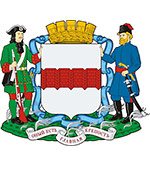
Omsk city map, Russia
Omsk city latest news and posts from our blog:.
10 November, 2019 / Tomsk - the view from above .
3 July, 2016 / Omsk - the view from above .
20 October, 2012 / The bear at the gate .
2 August, 2012 / Omsk city from bird's eye view .
14 December, 2011 / Time-lapse video of Omsk city .
More posts..
History of Omsk
Foundation of omsk.
The need to build a Russian fortress on the banks of the Irtysh at the mouth of the Om River arose in connection with the steppe nomadic peoples. In particular, with the Oirats, whose tribes in the first decades of the 17th century began to appear within the borders of the Russian state being under the onslaught of their external enemies and as a result of internal civil strife. However, various foreign and domestic political problems of Russia hindered the development and defense of the South Siberian borders.
The situation changed only at the beginning of the 18th century, when the Russian conquest of Siberia intensified. Since Peter I paid great attention to geographical research in the south, the expeditions of that time combined socio-political tasks and tasks of scientific research.
One of such expeditions was led by the Russian military and statesman, associate of Peter I, Major General Ivan Bukhgolts. The goals of the expedition, numbering about 3,000 people, were to search for ore and gold deposits, the discovery of trade routes to India and China, as well as the construction of towns on the Irtysh River.
The expedition left Tobolsk to the south along the Irtysh in July 1715. In the spring of 1716, after a conflict with the Dzungars in the north of today’s Kazakhstan, the remnants of the expedition (about 700 people) withdrew to the mouth of the Om River, where they laid a new fortress named Omsky ostrog (fortified settlement).
According to the census of 1725, 992 people lived in the fortress, in 1742 - 1,092 people. From the first years of its existence, it served as a place of exile for prisoners. After serving hard labor and imprisonment, a lot of them stayed in Omsk for permanent residence.
More Historical Facts…
Omsk in the second half of the 18th century
The ethnic composition of the region’s population was formed in the process of settling the territory. Russians, Germans, Ukrainians, Poles, Belarusians, and representatives of many other nationalities were sent here to serve or were exiled. The indigenous people of the region were the Siberian Tatars and Kazakhs, who switched to a sedentary lifestyle.
The foundation of the second Omsk fortress took place in 1762. The first fortress, although it occupied a favorable geographical position, was wooden and, by the middle of the 18th century, it was dilapidated. In 1765, new stone fortifications were constructed. The first stone structure of the fortress was the Resurrection Military Cathedral, built in 1773 and preserved to this day.
In the end of the 18th century, the Omsk fortress was one of the largest structures in the eastern part of the Russian Empire, its area was more than 30 hectares. In 1782, it was transformed into a town named Omsk within the Tobolsk Governorate. In 1785, the coat of arms of Omsk was approved.
Omsk became the center of management of the Siberian transport routes and the Siberian Cossack army, which not only guarded the South Siberian borders, but also made a huge contribution to the economic development of the steppe expanses of Kazakhstan, the annexation of Central Asia to the Russian Empire.
Omsk in the 19th century
The fire of 1819 destroyed almost half of the town including the archive and the magistrate of Omsk with all the first archival documents. Therefore information about the life of Omsk in the 18th - early 19th centuries is scarce and fragmentary. In 1825, the population of the town was about 9,000 people.
In 1829, the town’s development plan was approved. It was made by the famous Petersburg architect V.I. Geste, who took the city of St. Petersburg as a model with its wide avenues, huge neighborhoods, fountains, cast-iron bridges, and an abundance of green spaces.
The composition of the population of Omsk was not quite usual. In the middle of the 19th century, since Omsk was the center of the military and civil administration, the proportion of the military in the local population reached about 60%.
Fyodor Dostoevsky (one of the greatest psychological novelists in world literature), who served a term of hard labor in the Omsk prison in 1850-1854, in a letter to his brother gave Omsk the following description: “Omsk is a disgusting town. There are almost no trees. In summer, heat and wind with sand, in winter, a snowstorm. I have not seen nature. The town is dirty, military and highly depraved.”
By the second half of the 19th century, Omsk in its development outstripped many steppe towns and became not only an administrative, but also a commercial and industrial center. In 1861, in Omsk, there were 2,122 houses (31 stone houses), 34 factories and plants, about 20 thousand residents.
In 1892, the construction of the Trans-Siberian Railway began, which gave a new impetus to the economy of Siberian towns and positively influenced Omsk. The development of the Trans-Siberian Railway caused an increase in the urban population due to migrants who came to work from the central part of the Russian Empire. According to the 1897 census, 37.3 thousand people lived in Omsk. The town had 14 streets with a total length of more than 140 km and 13 squares.
Omsk in the first half of the 20th century
The beginning of the 20th century was a time of great changes for Siberia. Mass peasant colonization caused a sharp leap in the development of the region’s economy, primarily its agrarian sector, and the Trans-Siberian Railway ensured the inclusion of the local economy in the system of the All-Russian and European markets.
Due to its favorable economic and geographical position - at the intersection of the railway and the Irtysh River, in the middle of a vast agricultural territory - Omsk quickly turned into a large transport, trade and industrial center of Western Siberia and Governor-Generalship of the Steppes (Eastern and Central Kazakhstan).
Wholesale trade in bread, butter and other agricultural products was concentrated here. Omsk also became one of the industrial, social and cultural centers of Western Siberia. By 1903, the city’s population grew to 60 thousand people. In 1914, it had about 134.8 thousand residents. Omsk became the most populous city in Siberia.
During the Civil War on the territory of the former Russian Empire, from June 1918 to November 1919, Omsk was the residence of the Supreme Ruler of Russia, Admiral Alexander Kolchak, who declared this city the capital of white Russia opposing red Russia of the Bolsheviks. Soviet power was finally established in the city in 1920.
In the summer of 1921, an event took place that had a decisive impact on the cultural and economic life of Omsk. The functions of the administrative center of Siberia were transferred from it to the city of Novonikolaevsk (future Novosibirsk). In 1934, Omsk became the administrative center of a separate Omsk Oblast.
Over the years of industrialization, Omsk became one of the largest centers for agricultural engineering in the USSR. The metal-working industry also developed at a rapid pace. In 1939, Omsk numbered more than 288 thousand people.
During the Second World War, about 200 industrial enterprises were evacuated to Omsk, as well as 60 hospitals, dozens of educational institutions, theaters, museums, and hundreds of thousands of refugees.
Omsk after the Second World War
In the post-war years, new enterprises were put into operation in Omsk, all existing factories and plants were reconstructed and expanded. The industrial potential of the city was also strengthened by the Omsk oil refinery, the largest in the country. In connection with the rapid development of industry, especially petrochemical enterprises, the ecological situation deteriorated. The concentration of harmful substances in the air sharply increased. In 1964, the population of Omsk was about 702 thousand people.
In the 1970s-1980s, Omsk developed rapidly. In 1975, the city’s population exceeded 1 million. The most pressing problem was the ecological situation. Omsk was in the top 10 cities of Russia in terms of environmental pollution. Another problem that required an immediate solution was the development of passenger transport. The capacity of Omsk streets was exhausted, and therefore the construction of the subway became an urgent issue.
The economic crisis that gripped Russia after the collapse of the USSR had a negative impact on the economy of Omsk and the region as a whole. There was a significant decline in industrial production, construction volumes fell, and unemployment rose. A lot of organizations of the defense complex, research institutes, and design bureaus found themselves in a deep crisis without the state defense order.
The share of mechanical engineering and metalworking, light industry, and, to a lesser extent, chemical and petrochemical, forestry and woodworking industries decreased. At the same time, the share of the fuel industry, energy, and construction materials industry began to grow.
In the 2000s, Omsk again became one of the most important economic centers of Western Siberia with a developing mechanical engineering, petrochemical industry, various branches of the woodworking, construction industry, and a highly productive agro-industrial complex. In recent years, Omsk has also acquired the features of one of the largest Siberian centers of entrepreneurship and banking/financial activities.
Architecture of Omsk
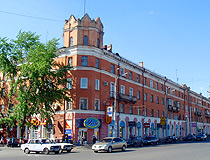
On the street in Omsk
Author: Tim Brown
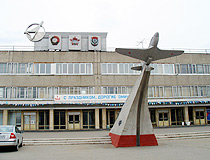
Yak-9 fighter aircraft in front of the aerospace engineering company Polyot in Omsk
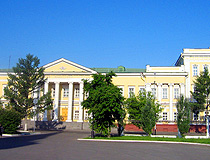
The Omsk Cadet Corps
Author: Stanislav Katsko
Omsk - Features
Omsk is located in the south of the West Siberian Plain at the confluence of the Om River into the Irtysh, about 150 km from the border of Russia with Kazakhstan. About 60% of all residents of Omsk Oblast live in Omsk. The City Day of Omsk is celebrated on the first Saturday of August.
The city’s coat of arms is very similar to the first coat of arms of Omsk approved by Empress Catherine II in 1785. It depicts a part of the brick fortifications, which symbolizes the reason for its foundation as a fortress and the center of the Siberian defensive line.
Omsk belongs to the temperate climatic zone with a continental climate of the forest-steppe of the West Siberian belt. It is distinguished by an abundance of sunlight. The average air temperature in January is minus 16.3 degrees Celsius, in July - plus 19.6 degrees Celsius. The highest wind speeds are observed in winter and spring, which is the reason for frequent snow and dust storms.
In the past, the ecological situation in Omsk was very unfavorable. Since 2011, the city’s environmental development rating has increased significantly. This was the result of large-scale modernization of many large industries (including the Omsk oil refinery). Today, road transport is the main source of air pollution in the city.
The level of pollution of the Omsk rivers - Irtysh and Om - remains consistently high. Swimming in them is prohibited. While industrial effluents are becoming more environmentally friendly, sewers are releasing waste products including diesel fuel and petroleum products into the rivers. Dust raised by dust storms is also a serious problem for the city as it contains a lot of harmful substances including lead.
The city’s industry is based on oil refining, petrochemistry, chemical industry, mechanical engineering (production of aerospace equipment, armored vehicles, agricultural equipment). Omsk is a major transport junction - the Trans-Siberian Railway runs through the city from west to east, and the navigable Irtysh River crosses it from south to north. Omsk Airport offers regular flights to Moscow, St. Petersburg, Novosibirsk, Tyumen, Surgut, Yekaterinburg, Krasnoyarsk, Salekhard, Kazan, Krasnodar, Sochi.
The unfinished subway of Omsk has become famous in Russia thanks to its only one fully built station. Its construction began back in 1992. However, due to funding problems, the completion of the first line was postponed numerous times. In 2019, it was finally decided to permanently stop construction. For local residents, because of the long wait for the completion of the construction, the Omsk metro symbolizes unrealizable hopes, they talk about it with irony.
In Omsk, there are practically no buildings higher than 50 meters, according to this parameter it is one of the lowest cities with a population of over one million. 130 architectural monuments are concentrated in the central part of the city, almost half of the total number.
Main Attractions of Omsk
Dormition Cathedral - the largest church in Omsk located in the very center of the city. The original church was built in 1891-1898. In 1935, it was completely destroyed. In 2005-2007, an exact copy of the building was restored in its original place. This is one of the most beautiful buildings in Omsk. At night, the building is illuminated and looks especially majestic. Tarskaya Street, 7.
Irtysh Embankment - the main walking street of Omsk with a picturesque view of the Irtysh River. Built in the middle of the 20th century, the embankment was reconstructed in the 2000s. You can walk along the alley on foot, ride rollerblades or a bike.
Merchant Batyushkin’s Mansion (1902). This architectural monument is located on the Irtysh Embankment. It is also known as the Kolchak’s House because Alexander Kolchak, the Supreme Ruler of Russia, lived in this building in 1919. One part of the building is occupied by the registry office of the Central District of Omsk. The Center for the Study of the History of the Russian Civil War is also open here. Irtyshskaya Naberezhnaya Street, 9.
Omsk State Museum of History and Local Lore - one of the oldest museums in Siberia and Russia founded in 1878. In total, this museum has over 200 thousand various objects of cultural, historical and artistic value. The museum is especially proud of such exhibits as the cast-iron figures of the Chinese lions Shi-Tzu, presented to the museum from China in 1895, as well as the skeleton of a woolly mammoth almost 3 meters high. Lenina Street, 23?.
Omsk Regional Museum of Fine Arts named after M.A. Vrubel - one of the largest museums of fine arts in Siberia. It has collections of foreign and Russian art from antiquity to the present day. In total, there are over 22 thousand works by painters, graphic artists and sculptors, as well as more than 1.5 thousand rare folios.
Walking through the exhibition halls, you can admire the canvases of Shishkin, Aivazovsky, Surikov, Repin, Serov, Vereshchagin. The exhibition of rare icons dating from the 17th-20th centuries is of constant interest among visitors, as well as a unique collection of jewelry made of precious metals found in the Scythian and Sarmatian burial mounds. Two buildings of the museum are located at Lenina Street 3 and 23.
In November 2019, a new exhibition was opened in a historical building at Muzeynaya Street, 4 - the exhibition of art of the 20th-21st centuries. The Hermitage-Siberia Center is located here too - the first representation of The State Hermitage Museum (the second-largest art museum in the world) beyond the Urals.
Chokana Valikhanova Street - a pedestrian street located in the historic part of Omsk. The street is decorated with abstract architectural forms, flower beds, wrought-iron lanterns. The walking area ends with an observation deck with a picturesque view of the Irtysh River.
Museum of Kondraty Belov . The museum of this landscape painter born in Omsk can be found in a picturesque wooden house, which is considered one of the most interesting architectural monuments of Omsk. The exposition tells about the life and work of Kondraty Belov, as well as about the history of the building itself.
In total, this museum has about 700 exhibits. The permanent exhibition also includes works by Kondraty Belov’s son Stanislav and paintings by some other local artists. In addition, temporary exhibitions of contemporary Omsk artists are regularly held here. Chokana Valikhanova Street, 10.
Plumber Stepanych Monument - an unusual sculpture located in the center of Omsk, which you can literally stumble upon while walking along Lenin Street between the houses #12 and #14. Leaning out of the hatch, the plumber is depicted as realistic and life-size as possible. It is among the most photographed monuments in Omsk. There is a similar sculpture in Bratislava, the capital of Slovakia.
Lyuba Monument . This sculpture, located on the opposite side of Lenin Street from the monument to the plumber Stepanych, is especially loved by Omsk residents and tourists, who love to be photographed against its background.
This beauty in a lace dress with a neckline and a crinoline sitting on an openwork bench and reading a novel had a real prototype - Lyubov (diminutively Lyuba or Lyubasha) Gasford, the wife of the Governor-General of Siberia, who lived in Omsk in the 19th century and died at a young age due to illness. One of the streets of Omsk and the park are named in her memory. She is a local symbol of femininity and beauty.
Omsk Fire Tower - a picturesque architectural monument built at the beginning of the 20th century. Inside the tower there are museum expositions dedicated to the local fire brigade and the history of tower construction. Internatsionalnaya Street, 41?.
Park of Culture and Rest named after the 30th anniversary of the Komsomol - a popular place for walks, recreation and entertainment of Omsk residents and tourists, which has retained “the spirit of the Soviet era” in its name. Today, on an area of 73 hectares, several zones have been organized, various types of recreation are presented. There are walking alleys, ponds, water activities, for example, riding on hydro-scooters.
The ice town is open in winter, the Return of the Dinosaurs exhibition - in summer. The “House Upside Down” exposition is also popular with tourists. This park is a place for mass festivities, city celebrations and events. Maslenitsa, Christmas, City Day, and other holidays are celebrated here. Maslennikova Street, 136.
Natural Park “Bird Harbor” - a specially protected area located on the path of bird migration in the central part of Omsk. During autumn flights, up to 3 thousand birds stop here for rest. It is a great place to enjoy nature, walk along the eco-trail, and observe the life of birds. The park is situated in the floodplain on the left bank of the Irtysh River next to the Victory Park on Yeniseyskaya Street.
Omsk city of Russia photos
Pictures of omsk.
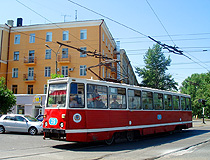
Bogdan Khmelnitsky Monument in Omsk
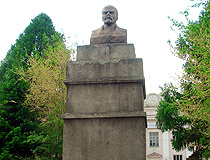
Lenin Monument in Omsk
Churches of Omsk
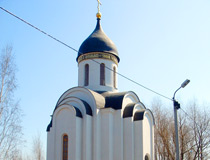
Chapel of St. George in Omsk
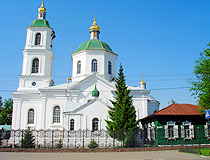
Cathedral of the Exaltation of the Holy Cross in Omsk
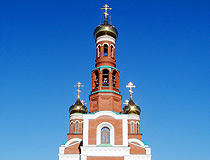
Cathedral of the Nativity in Omsk
Sights of Omsk
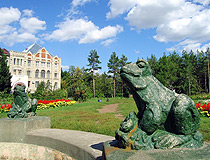
Fountain with frogs in the park next to the main building of the Agricultural Academy in Omsk
Author: Alexey Pavlov
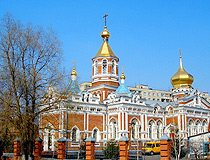
Church of St. Nicholas in Omsk
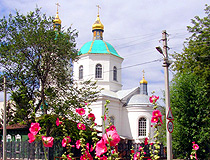
Exaltation of the Holy Cross Cathedral in Omsk
Author: Stanislav Vosinsky
The questions of our visitors
- Currently 2.94/5
Rating: 2.9 /5 (211 votes cast)
- Search Please fill out this field.
- Newsletters
- More to Explore
- Things To Do
The Top 12 Things to Do in Omsk
Feel the love in the very heart of Russia
In Russia, all roads lead to Moscow , on account of the city's status as the national capital and its importance throughout history. If geography were the deciding factor, however, the Siberian city of Omsk would be the point where all Russia's roads converge—it's located literally in the heart of the country, approximately as far from Vladivostok as it is from the Belarusian border. Omsk boasts a spate of exciting attractions, even if you simply make a stop here as you ride the Trans-Siberian Railway eastward or westward.
Marvel at Assumption Cathedral
Chelsea Hicks/Flickr/CC BY 2.0
Orthodox architecture never gets old, even if you've been traveling in Russia for a long time. This is particularly the case when it comes to the Assumption Cathedral of Omsk, whose gold-and-turquoise domes look resplendent under the blue skies that bless Omsk during the warmer months of the year. The cathedral was built in 1891 under the orders Nicholas, the last Tsar of Russia.
Time Travel at Omsk Fortress
Ogg-omsk/Wikimedia Commons/CC BY-SA 3.0
The bad news? Much of what was once Omsk Fortress is now a residential area, with the only notable landmark that still stands being Tobolsk Gate (think Paris' Arc de Triomphe , but yellow and smaller). The good news? There's essentially no reason for a military fortification to exist in today's peaceful Omsk, which means you can stroll amid parks and cafés and imagine the area being war-torn—a small sacrifice to make in exchange for not being blown to bits.
Go Green at Ptich'ya Gavan'
Forinrap/Wikimedia Commons/CC BY-SA 4.0
Or white, as it were: Omsk is covered with snow several months of the year, which means that its prized Ptich'ya Gavan' central park is often more of a winter wonderland than the green reprieve you experience in summer. The park is popular with local families, to whom you can say "Privet" (Hello) as you walk past.
Walk on Omsk's Artsy Side
G0rn/Wikimedia Commons/CC BY 3.0
Although the building that houses Omsk District Museum of Visual Arts is unmistakably Russian, the collection you find inside is surprisingly eclectic for a city deep in Russia's interior. Recent collections have included a revival of Van Gogh's great works, among others. This is a particularly enjoyable Omsk attraction on cold winter days, when temperatures can drop far below freezing and sunshine can be rare.
Shoot for the Moon
Worldwide Planetarium Database
Though Omsk is a relatively large city, the skies over it become dark enough in the evening for stargazing. While visitors are not permitted to use the expensive telescopes housed inside, exhibits inside the museum provide a fascinating look into the cosmos, narrated by expert astronomical guides.
Shop on Lenin Street
yykkaa/Getty Images
Lenin Street's name is appropriate: Although it's the high street of a city thousands of miles from Moscow, the European-style architecture and cosmopolitan vibe you feel as you stroll past its boutique and cafés evokes the capital of Russia more than its forlorn interior. Local specialties you can purchase here include rustic jams made from local berries (and even, in some shops, cedar cones), as well as handmade rugs from Kazakhstan, which sits just south of Omsk.
Sample Siberian Cuisine
Quynh Anh Nguyen/Getty Images
Speaking of unique Siberian food, it's not just preserves made from the fruits of evergreen trees. Omsk is a great place to discover the flavors of Russia's wild interior, whether you eat zagutai and stroganini (Siberia's take on sushi) or classic Russian plmeni dumplings filled with decidedly Siberian ingredients, such as bear and rabbit meat. Vkusno ! (That's Russian for "delicious"!)
Enjoy Historical Houses—While You Still Can
Simon Richmond/Getty Images
The wooden houses that line Nikolskiy Prospekt aren't protected, but they should be. Historical structures that are unfortunately in a state of disrepair, these houses are slated for demolition at some unspecific point in the future. Be sure to catch a glimpse of these historical house before they're gone. There will, however, be at least one left standing for a long time. The Omsk State Art Museum is in a traditional wooden house.
Go to the Circus
Vladislav Domnich/Getty Images
Omsk State Circus is a popular spot for local families, whose children love the opportunity to see acrobatic performances and animals that wouldn't otherwise make appearance in Siberia. If you do attend a show here, keep in mind that ethics with regard to animal treatment might not match up with those in North America or Western Europe, to say nothing of the smell that can pervade the auditorium during and even after a show.
Be a Drama Queen
While there's no guarantee that any shows will be playing at Omsk Drama Theater at the time of your trip, a visit to this 19th century building is a spectacle in and of itself. While not as huge, say, as Moscow's Bolshoi Theatre, it's nonetheless an ornate architectural wonder that hearkens back to a glorious time in history. The interior of the theater is even open during the daytime; ask the person who's inside if any tours are available when you turn up.
Explore Cities Deeper in Siberia
Tuul & Bruno Morandi/Getty Images
Siberia starts in Omsk, even if you can't continue far into it. If you don't plan to travel on the Trans-Siberian Railway, take one of two day trips from Omsk. Travel to Tobolsk, whose hilltop Kremlin is one of the most picturesque in all of Russia, and whose beauty inspired a photo by Russian Prime Minister Dmitry Medvedev that ended up winning several awards. Or visit Tomsk, where you'll find a botanical garden dedicated to Siberian flora, and a museum that celebrates wooden architecture.
Ride the Trans-Siberian Railway
lvinst/Getty Images
The idea of leaving Omsk behind can seem difficult, especially now that you've gotten to know this city in the heart of Siberia as well as you have. The mint-colored facade of Omsk Railway Station will make you smile, however, even if you're crying inside as you depart. Though it's not quite on the mid-line of the Trans-Siberian route between Moscow and Beijing , Omsk is a worthy starting place to begin a journey to either. If you head east make sure to stop in Irkutsk , the home of Lake Baikal and another underrated Siberian city.
Related Articles
More related articles.
- Visit the University of Nebraska–Lincoln
- Apply to the University of Nebraska–Lincoln
- Give to the University of Nebraska–Lincoln
Search Form
Usda nass to collect 2024 small grain production and stocks data.

During the first two weeks of September, growers of small grains around the country will be contacted by the U.S. Department of Agriculture’s National Agricultural Statistics Service (NASS). The agency is taking a comprehensive look into the 2024 production and supply of small grains, which include wheat, oats, barley, and rye.
“The small grains industry is important to Nebraska agriculture, and it is crucial for everyone to have accurate data about this key sector of the economy,” said NASS Northern Plains Regional Director Nicholas Streff. “We will contact more than 3,100 producers in Nebraska to accurately measure 2024 acreage, yield, and production for small grains and the quantities of grains and oilseeds stored on farm. The results are used by farmers and ranchers, USDA, businesses, exporters, researchers, economists, policymakers, and others who use the survey information in making a wide range of decisions that benefit the producer.”
The data collected from this survey, along with additional information, will be used to help set small grain acreage, yield, and production estimates, which will be available on the NASS website and in NASS’s Quick Stats database .
“NASS safeguards the privacy of all respondents and publishes only aggregate data, ensuring that no individual operation or producer can be identified,” Streff said. “We recognize that this is a hectic time for farmers and ranchers, but the information they provide becomes useful data for decision-making on the farm, for federal farm programs, and the markets. I urge them to respond to this survey and thank them for their time and cooperation.”
Survey results will be published in several reports, including the annual Small Grains Summary and the quarterly Grain Stocks report, both to be released on Monday, Sept. 30. These survey data also contribute to USDA’s World Agricultural Outlook Board’s monthly World Agricultural Supply and Demand Estimates. All NASS reports are available online . For more information, call the NASS Nebraska Field Office at 800-582-6443 .
Online Master of Science in Agronomy
With a focus on industry applications and research, the online program is designed with maximum flexibility for today's working professionals.

What’s a campus tour?
A campus tour is a visit by prospective students to a college or university to tour the facilities, meet faculty and students, and learn about academic programs and campus life. It helps students make informed decisions about college options by giving them firsthand experience and a chance to ask questions. A college visit is important in the college selection process. It helps students have a fulfilling and successful college experience.
Also Found On
- Word of the day
- Random word
Definitions
From the american heritage® dictionary of the english language, 5th edition..
- A city of south-central Russia on the Irtysh River. On the Trans-Siberian Railroad, it is a major river port and transportation hub. The city was founded in 1716.
from Wiktionary , Creative Commons Attribution/Share-Alike License.
- proper noun Seventh largest city in Russia , centre of Omsk oblast .
from WordNet 3.0 Copyright 2006 by Princeton University. All rights reserved.
- noun a city in the Asian part of Russia
Etymologies
Sorry, no etymologies found.

Help support Wordnik (and make this page ad-free) by adopting the word Omsk .
The Czech-born Jagr, 36, a right wing who has topped rosters for the Pittsburgh Penguins, the Washington Capitals, and the New York Rangers since 1990, is now playing for Avangard Omsk , of the new Continental Hockey League, in Omsk, Siberia.
Jagr, wearing number 68 to commemorate the Prague Spring, waits to play in Omsk . Image credit: Utkin Igor/Itar-Tass Photo/Corbis
Watch them smile to themselves as they refute objections and expound implications of Stalin's monetary policy on rural electrification in Omsk . If there are two of them in the car, you just might do a Gemini and climb out the window to pull off a carjacking.
Archive 2007-11-01 2007
Astrology and Traffic Tie-ups 2007
Ultimately, he said it was a matter of stability, that he wanted a three-year contract and a place to call home, even if that means going to an outpost like Omsk , which is far more a part of Siberia than continental Europe.
Archive 2008-07-01 James Mirtle 2008
Nine-time NHL All-Star Jaromir Jagr shocked the hockey world in 2008 when he joined Avangard Omsk at age 36, before rejoining the NHL this summer.
Hockey Stars Killed in Russian Crash Gregory L. White 2011
The firebrand championing the indigenous Komi people was none other than Yury Spiridonov, an ethnically Russian oil miner and party worker, born in Omsk and educated in Sverdlovsk, who had once gotten into trouble for snapping at someone who tried to address him in Komi: “Speak in a way that can be understood.”
The Return Daniel Treisman 2011
Before returning to the NHL this season with the Philadelphia Flyers, Jagr had played three years for Avangard Omsk , a franchise in Russia's Kontinental Hockey League.
Why Didn't New York Keep Jagr? Mike Sielski 2011
Related Words
Log in or sign up to add your own related words.
hypernyms (3)
Words that are more generic or abstract.
- urban center
Word visualization
Log in or sign up to get involved in the conversation. It's quick and easy.
- About Wordnik
- @[email protected]
- github.com/wordnik
- Send Us Feedback!
- Need Support?
- Advanced Search
Wordnik is a 501(c)(3) non-profit organization, EIN #47-2198092.

IMAGES
COMMENTS
Learn how to make the most of your college visit with these 14 tips from U.S. News, including what to do before, during and after your campus tour.
A campus visit is a planned visit to a college or university campus. It involves a guided campus tour, information sessions, and meeting with admissions officers. Visitors can interact with current students, explore the campus community, and see if the college matches their interests and goals. The purpose is to provide firsthand experience and ...
Along with a tour of campus, you should get the chance to meet current and prospective students, connect with faculty, learn about academics and extracurriculars, and get practical information on housing, dining, support services, and financial aid. Typically, the event lasts a day or half-day and is held in the spring.
Visiting a college campus is a great way to get more information about a school and help you decide if it's a good fit for you. A campus tour helps you get a sense of what a college—and life at that college—is like.
Campus Visits: Know Before You Go You can only tell so much from colleges' websites and brochures. By spending time on campus, you can speak in person with an admissions officer as well as students and get a good idea of what academic and social life are like there. When it's time to choose a college to attend, you'll be better prepared to make an informed decision.
Whether you're a student or a professional, a visit report helps you document the procedures and processes at an industrial or corporate location. These reports are fairly straightforward. Describe the site first and explain what you did...
Chat up the real experts on campus—the students. Our list of questions to ask on a college tour will help you figure out what a school is really like.
When to Visit Colleges Visiting a college campus allows you to experience the campus atmosphere firsthand, interact with current students, and gain valuable insights into the college's academic programs and extracurricular offerings. Here's what you need to know to make the most of your visits.
Unique College Campus Visits Campus tours can be self-guided, virtual or even on golf carts.
Explore Harvard from Home Use our Virtual Tour to discover spaces that aren't even available on an in-person campus tour, such as classrooms, laboratories, residence halls, and more. Even better, it's available 24 hours a day, seven days a week, and never reaches capacity.
Here are 32 example questions, collected from college admissions and enrollment professions, that students don't always think to ask on college visits. These questions - edited for length or ...
Campus Visit Checklist Visiting a college campus helps you get a sense of what a college — and life at that college — is like. This can help you decide whether the college is right for you.
In brief, the first visit included a college information session and campus tour, the second visit focused on exposing students to different departments and degree paths available, and the third ...
Seven Admissions Questions to Ask When You're on a Campus Visit. Don't let good information gathering opportunities slip through your fingers, especially on all-important college admissions queries. Be sure to ask these admissions questions during your next college visit, and pave the way for a smooth transition from high school life to ...
The present report is a compilation of the events, places visited visited and activities of a 10. days educational educational trip trip to to Kanyakumari Kanyakumari and and Trivandrum Trivandrum organized organized by by the the Department Department of of. Zoology Deshbandhu College, University University of of Delhi Delhi from 28th December ...
Campus Ratings rom 1 (low) to 5 (high). Jot down your impressions— things you like or don't like, thi gs you want to remember Take a campus tour. Take pictures. Eat in the cafeteria. Pick up an application.
IT REPORT OF MAITREYI COLLEGE STUDENTS Maitreyi College student visit was arranged at Amity Institute of Nanotechnology (AINT), Amity Univ. rsity, Noida on 19 January 2018 (Friday). Total 46 students from different fields of science and 5 fa. ulty members participated in the program. The main objective of the visit was to make the young minds ...
Why Visit Colleges? A key part of deciding which college to go to is finding a good fit. And a great way to get more information is to visit the colleges in person. Virtual tours are also a great way to learn more about a campus. It can help you determine whether a college is the right place for you and prepare you for a campus visit at your ...
If you have questions about what college is like, campus tour guides have the answers. You'll get a lot out of visiting colleges, but at Saint Louis University, the campus tour guides are current undergraduate students — so they won't just tell you about dorms, they can also tell you where to get a good grilled cheese sandwich, if they feel safe walking around campus at night and if you can ...
Annual Report 2023‑24. CONTENTS. Vice President's Letter; Org Chart ... Dual Language WSU Campus Tour Experience . The CATS team collaborated with WSU Online to create and immersive dual language tour experience in English and Spanish that gives perspective students a chance to become familiar with resources and connections on campus to ...
How to Make the Most of Virtual College Tours Virtual college tours can be a useful tool for weighing options or previewing a campus.
Omsk - Overview Omsk is one of the largest cities in Russia, a major scientific, cultural, sports, transport, and industrial center. The administrative center of Omsk Oblast, it is the second most populous city in Siberia.
Discover the cultural, historical, and natural attractions of Omsk, the heart of Siberia, with this guide to the top 12 things to do in the city.
City Campus Graduate Welcome Resource Fair Date: August 22, 2024 Time: 10 am to 12 pm Location: Seaton Hall Quad No registration required. ... Receive future newsletters from The Graduate Report. Visit this link to subscribe to the email list. Announce. 1400 R Street Lincoln, NE 68588 402-472-7211. Related Links. Information Technology Services ...
Survey results will be published in several reports, including the annual Small Grains Summary and the quarterly Grain Stocks report, both to be released on Monday, Sept. 30. These survey data also contribute to USDA's World Agricultural Outlook Board's monthly World Agricultural Supply and Demand Estimates. All NASS reports are available ...
Omsk ( / ˈɒmsk /; Russian: Омск, IPA: [omsk]) is the administrative center and largest city of Omsk Oblast, Russia. It is situated in southwestern Siberia and has a population of over 1.1 million. Omsk is the third largest city in Siberia after Novosibirsk and Krasnoyarsk, and the twelfth-largest city in Russia. [ 12] It is an important transport node, serving as a train station for the ...
A campus tour is a visit by prospective students to a college or university to tour the facilities, meet faculty and students, and learn about academic programs and campus life. It helps students make informed decisions about college options by giving them firsthand experience and a chance to ask questions. A college visit is important in the college selection process. It helps students have a ...
The Czech-born Jagr, 36, a right wing who has topped rosters for the Pittsburgh Penguins, the Washington Capitals, and the New York Rangers since 1990, is now playing for Avangard Omsk, of the new Continental Hockey League, in Omsk, Siberia.. Exile 2008. The Czech-born Jagr, 36, a right wing who has topped rosters for the Pittsburgh Penguins, the Washington Capitals, and the New York Rangers ...
The 19-year-old Texas A&M sophomore learned in the thick of July that she would see a $10,000 drop in financial aid, well after she had to sign up for on-campus housing and enroll in classes.
The University restricted the historically open Morningside campus to Columbia ID holders prior to the protest, marking the semester's first such limitation in relation to demonstrations, and allowed the NYPD on campus. Hundreds of demonstrators flood South Lawn on Oct. 12, 2023, for a protest organized by SJP and JVP and a counterprotest ...